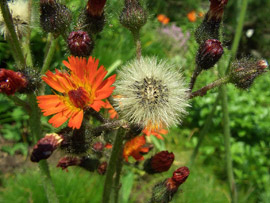
Orange hawkweed (Hieracium aurantiacum) is a small, perennial, dandelion-like herb topped with bright orange flowers. Introduced from Europe as an ornamental plant, it has in many areas spread out of control to colonize varying land types including grasslands, forest meadows, abandoned fields, clear cuts, and lawns and gardens. Fortunately, orange hawkweed is not known to be established in Multnomah County. Nearby populations just across the border in Clackamas and Hood River Counties around Lolo Pass Road threaten our district so keep an eye out for this plant in that area of the Mount Hood National Forest.
Although orange hawkweed grows best in the sun, it can tolerate and will grow in the shade. Orange Hawkweed can quickly grow into large and dense patches to form extensive mats of rosettes that exclude other plant species. Plants reproduce from prolific seed production and through vegetative spread. Each flower is capable of producing 12-50 tiny seeds. The seeds can be dispersed by wind, water, or by hitch hiking on animals and people and remain viable in the soil for up to 7 years. Above ground stolons, similar to strawberry runners, radiate from small buds in the basal rosette and create new rosettes where they root down. Rhizomes also spread underground from the root system sending new plants to the soil surface. Decaying leaves of orange hawkweed produce chemicals that are toxic to and inhibit seed germination and the regeneration of other plants.
Identification
Similar to dandelions, orange hawkweed lives most of its life as a basal rosette of leaves before sending up its typically leafless flowering stalk. The basal leaves are lance, tear drop, or spatula shaped and are very hairy with entire or minutely toothed margins. They are 4-6 inches long and are dark green above and lighter green beneath. The stems are also very hairy and are typically around 12 inches tall but can grow to nearly 3 feet. Both leaves and stems will exude a milky latex when they are cut or broken. Above ground stolons, similar to strawberry runners, can be seen growing between rosettes. Orange Hawkweed is most easily identified when it is actively flowering from June to September. The flowers are orange to red and resemble the flower of a dandelion except with notched tips. Orange Hawkweed can have up to 30 flowers at the tip of a single stem. Seeds are dark brown or black, cylindrical, elongated, barbed and bristled.
Report Sightings!
If you think you have found this plant please report it immediately. This plant is on our EDRR list, and we provide free control. Report a sighting!
More Photos
To see more photos of orange hawkweed click here
